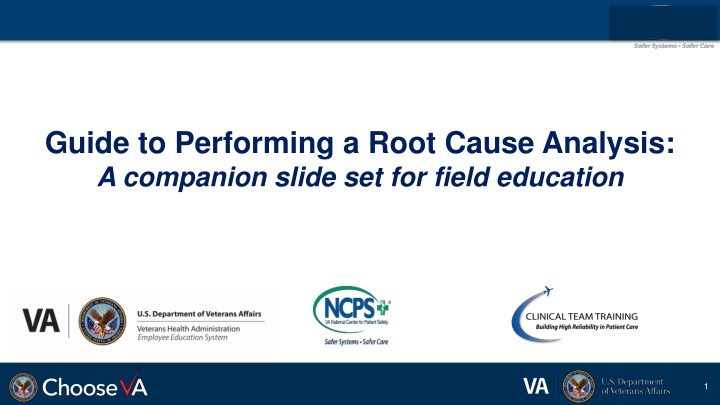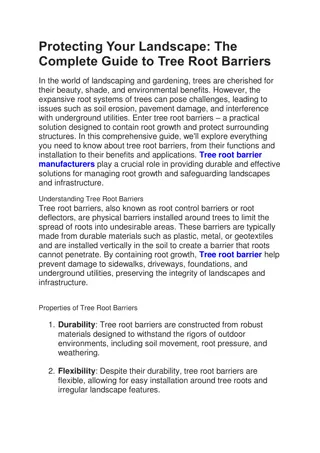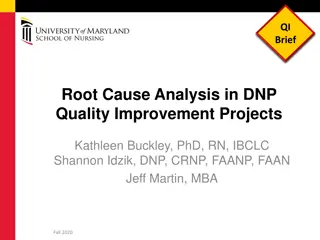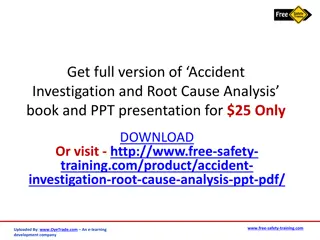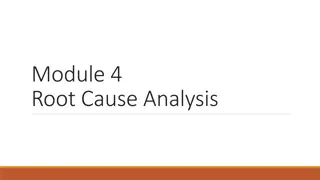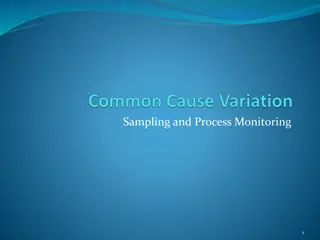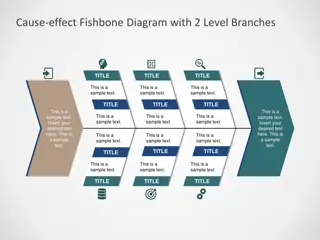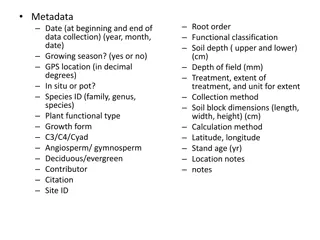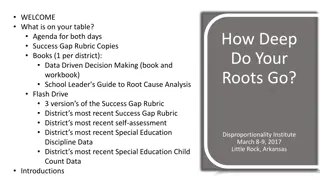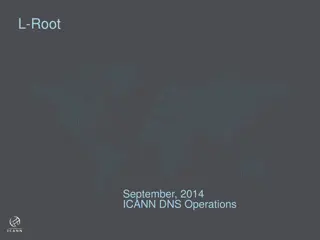Comprehensive Guide to Root Cause Analysis in Healthcare
This guide provides a detailed overview of Root Cause Analysis (RCA) in healthcare, emphasizing the importance of identifying basic causal factors underlying system failures to improve patient safety. It covers the purpose of the guidebook, when an RCA is necessary, characteristics of an RCA, and the steps required for completing an RCA according to established protocols. The guide stresses the importance of systematic investigation and analysis to uncover root causes and develop effective solutions.
Download Presentation

Please find below an Image/Link to download the presentation.
The content on the website is provided AS IS for your information and personal use only. It may not be sold, licensed, or shared on other websites without obtaining consent from the author.If you encounter any issues during the download, it is possible that the publisher has removed the file from their server.
You are allowed to download the files provided on this website for personal or commercial use, subject to the condition that they are used lawfully. All files are the property of their respective owners.
The content on the website is provided AS IS for your information and personal use only. It may not be sold, licensed, or shared on other websites without obtaining consent from the author.
E N D
Presentation Transcript
Guide to Performing a Root Cause Analysis: A companion slide set for field education 1
Introduction RCA Guidebook, p 4 Patient safety events can cause serious harm or death. System and process flaws cause most failures and require systematic investigation and analysis to unearth root causes and develop solutions. Most common comprehensive systematic analysis: Root Cause Analysis (RCA). Process to identify basic causal factor(s) underlying system failures (the root; source below surface; obscured) Adverse outcomes, sentinel events, or clusters of less serious incidents or near misses (the weed; problem above surface; obvious) 2
Purpose of the Guidebook RCA Guidebook, p 4 To describe process steps to complete an RCA according to protocols found in: Veteran Health Administration (VHA) Patient Safety Program VHA Patient Safety Handbook 1050.01 To identify intended users of the guidebook and those involved in RCAs To provide definitions for key terms, RCA examples, information about Aggregate Review RCAs, and the RCA Quality Analysis Tool (QAT) in multiple appendices 3
Determining When an RCA is Required RCA Guidebook, p 5 Sentinel events, serious safety event (SE), any event with a substantial, direct, and high probability that a serious SE would have ensued, but did not, due to intervention/chance Events with a Safety Assessment Code (SAC) of Actual or Potential 3 Falls, Missing Patient, Medication Events with Potential 3 SAC Do not require an individual RCA; may be done at discretion of facility Aggregate and analyze together or review for inclusion in Patient Safety Assessment Tool (PSAT) All RCAs must be formally chartered and signed by facility Director. 4
Characteristics of a Root Cause Analysis RCA Guidebook, p 5 Adhere to procedures in RCA Guidebook and charter memorandum All documents must have the term Root Cause Analysis to be protected/confidential: 38 U.S.C. 5705 Implementing regulations (VHA Directive 2008-077, Quality Management (QM) and Patient Safety Activities that Can Generate Confidential Documents) NOT protected: email or RCAs if RCA charter memorandum unsigned by facility Director 5
Characteristics of a Root Cause Analysis Within 45 days of facility becoming aware that an RCA is required, RCAs MUST be: Completed, Signed by facility Director or designee, and Documented in SPOT Follow the process steps provided in the RCA Guidebook and explained more fully in subsequent sections and appendices 6
Root Cause Analysis Flow Diagram RCA Guidebook, p 6 The crucial process steps in the Root Cause Analysis include: Getting Started day 1 thru 14 Analysis 15-45 days Feedback Implementation and Measurement 7
Completing an RCA, Step 1: Charter a Team RCA Guidebook, p 7 Composition (4-6 members): Leader, Advisor, Subject Matter Expert (SME), non-SME Large enough for diverse viewpoints and opinions Small enough to keep meetings manageable Describe professional titles and specific roles of individuals on RCA team in charter and may also be included in charter memorandum Recorder needed to document meeting notes, interviews, Q&As, and guide next steps 8
Completing an RCA, Step 2: Conduct Just in Time Training RCA Guidebook, p 8 Conduct RCA team training with every RCA event, even if no new members are present. Senior leader greeting shows tangible executive leadership support for RCA team Just in Time Training Video (run time 18:27) Just in Time Training should include: an overview of the RCA process; information on confidentiality, timeline of the process, roles and responsibilities of team members, event briefing, and milestones with meeting dates/times established at first meeting. 9
Completing an RCA, Step 3: Create the Initial Flow Diagram RCA Guidebook, p 9 Graphically documents known and relevant facts of the event 10
11 Initial Sequence of Events Example Patient admitted to VA Hospital for Abdominal Distension Patient at Comm. Living Center (CLC) for Knee Surgery Rehab Patient taken to x-ray Patient fell at CLC Abdominal Distension resolved non- surgically Patient injured newly replaced knee Patient fell getting off x-ray table Patient required additional knee surgery 11
12 Identify Information Gaps Patient admitted to VA Hospital for Abdominal Distension Patient at Comm. Living Center (CLC) for Knee Surgery Rehab Patient taken to x-ray Patient fell at CLC recently Was this communicated in the handoff? When was the admission assessment complete? How is fall risk communicated to Radiology? What is listed on the ticket to ride ? Abdominal Distension resolved non- surgically Patient injured newly replaced knee Patient fell getting off x-ray table Patient required additional knee surgery What is the process of assisting patients in radiology? Do radiology staff assess fall risk? 12
Completing an RCA, Step 4: Craft the Initial Understanding RCA Guidebook, p 10 Narrative expression of the Initial Flow Diagram Adds greater detail of events Staffing, equipment, products, environmental, or other influencing factors Discovers the facts Asks why for each item in the flow diagram Identifies missing pieces Identifies resources Policies, medical records, or committee minutes Determines who to interview 13
Completing an RCA, Step 5: Identify Information Gaps RCA Guidebook, p 11 Determine missing information Gather data related to the event Identify system and process vulnerabilities Visit the scene of the event Simulate event if possible 14
Completing an RCA, Step 6: Use Triage Questions RCA Guidebook, p 11 Standard set of questions Assists the team in considering areas of inquiry Reveals vulnerabilities in systems and work processes Link to Triage Questions 15
Completing an RCA, Step 7: Collect Resources and Prepare for Interviews RCA Guidebook, p 12 Identify team members to obtain and review documents Identify individuals to be interviewed Determine interview date/time and location Draft interview questions 16
Completing an RCA, Step 8: Conduct the Safety Investigation RCA Guidebook, p 12 17
Completing an RCA, Step 8: Conduct the Safety Investigation Develop a strategy to fill in the information gaps including but not limited to: Review pertinent documents Interviews Simulate the event simulation and debriefing in event analysis helped identify multiple, underlying causes of teamwork errors, latent risk factors (things that make errors more likely), and more specifically system errors in surgical cases. Lobos & Ward, 2019 Literature review determine evidence-based practices prevalence of incidence Data pull JPSR SPOT 18
Completing an RCA, Step 9: Create the Final Flow Diagram RCA Guidebook, p 13 The Final Flow Diagram is a graphic of the first known relevant fact through the final known relevant fact. It is developed using all the information obtained in fact finding investigation. 19
Completing an RCA, Step 10: Create the Cause-and-Effect Diagram RCA Guidebook, p 15 Required! What is a cause-and-effect diagram? Systematic method Determines causal links Shows starting point and represents: Preventing problem from: Occurring (e.g., near miss) Recurring (e.g., a fire happened) 20
Completing an RCA, Step 10: Create the Cause-and-Effect Diagram Work backwards with "caused by" statements For specific actions For specific conditions Keep working backwards until you can t! 21
RCA Completing an RCA, Step 10: Create the Cause-and-Effect Diagram Guidebook, p 16 ACTION Light a match PRIMARY EFFECT-CAUSE CONDITION PRIMARY EFFECT OF CONSEQUENCE/ PROBLEM STATEMENT FIRE! CONDITION Oxygen CONDITION Ignition Source CONDITION Combustible Material 22
RCA Completing an RCA, Step 10: Create the Cause-and-Effect Diagram Guidebook, p 17 ACTION ACTION CAUSE AND EFFECT DIAGRAMS ARE NOT STRAIGHT FORWARD ACTION ACTION ACTION ACTION ACTION ACTION ACTION ACTION ACTION ACTION ACTION ACTION ACTION ACTION ACTION PROBLEM STATEMENT ACTION CONDITION CONDITION CONDITION CONDITION CONDITION CONDITION CONDITION CONDITION CONDITION CONDITION CONDITION CONDITION CONDITION CONDITION CONDITION CONDITION CONDITION CONDITION CONDITION CONDITION CONDITION 23
24 RCA Completing an RCA, Step 10: Create the Cause-and-Effect Diagram Guidebook, p 18 WHEN DO WE STOP? 24
Completing an RCA, Step 10: Create the Cause-and-Effect Diagram STOP! When the RCA Team says: Who cares? We don t know anymore! That s just how it is! Or similar statements.. 25
Completing an RCA, Step 11: Craft the Final Understanding RCA Guidebook, p 19 Separate from & complimentary to the Final Flow Diagram Written as a narrative Complete understanding of flow diagram Includes all work of RCA Team Begin with first known relevant fact; end with last known relevant fact Addresses missing information & gaps in knowledge Helps understand the event and its root cause(s) and contributing factor(s) 26
Completing an RCA, Step 12: Identify & Craft Root Cause and Contributing Factor Statements RCA Guidebook, p 19 Synthesize the RCA team's findings from: All previous work Depicted in the Final Understanding Identify what system elements must be improved 27
Completing an RCA, Step 12: Identify & Craft Root Cause and Contributing Factor Statements Statements: Address causal factors or action plans Contribute the most Have the greatest impact on the system Have potential to prevent recurrence Need to Lead the team to an appropriate action plan Be understood by the cold reader Use the: 5 Rules of Causation (reviewed on the following slides) 28
Completing an RCA, Step 12: Identify & Craft Root Cause and Contributing Factor Statements RCA Guidebook, p 21 RULE 1: Clearly show cause and effect relationship Not compliant: The Pharmacist was fatigued. Compliant: Pharmacists are regularly scheduled 60 hours per week, which led to increased levels of fatigue, increasing the likelihood that dosing instructions would be misread. RULE 2: Use specific and accurate descriptors Not compliant: The poorly written manual increased the likelihood that a pump would be programmed incorrectly. Compliant: The pump manual had 8-point font and no illustrations; as a result, nursing staff rarely used it, increasing the likelihood that the pump would be programmed incorrectly. 29
Completing an RCA, Step 12: Identify Root Causes and Craft Contributing Factor Statements RCA RULE 3: Human errors must have a preceding cause Not compliant: The resident selected the wrong dose in CPRS which led to the patient being overdosed. Guidebook, p 21 Compliant: Drugs in the CPOE system are presented to the user without sufficient space between different doses on the screen, which led to the wrong dose being selected, increasing the likelihood of an overdose. RULE 4: Violations of procedures are not root causes Not compliant: The techs did not follow the procedure for CT scans, which led to the patient receiving an air bolus from an empty syringe, resulting in a fatal air embolism. Compliant: Noise and confusion in the prep area, coupled with production pressures, increased the likelihood that steps in the CT scan protocol would be missed, which led to the injection of an air embolism from using an empty syringe. 30
Completing an RCA, Step 12: Identify Root Causes and Craft Contributing Factor Statements RCA Guidebook, p 22 RULE 5: Failure to act ***Only causal if there is a preexisting duty to act*** Not compliant: The nurse did not check for STAT orders every hour, which led to a delay in the start of anticoagulation therapy, increasing the likelihood of a blood clot. Compliant: The absence of an assignment for designated RNs to check orders at specified times, led to STAT orders being missed or delayed, which increased the likelihood of delays for patients needing immediate therapy. 31
Completing an RCA, Step 12: Identify & Craft Root Cause and Contributing Factor Statements The requirement for the pharmacist to simultaneously dispense medication and carry out administrative duties led to multiple interruptions and distractions during the medication dispensing process, which increased the likelihood that an inappropriate dose would be selected. 32
Completing an RCA, Step 13: Develop Action Statements RCA Guidebook, p 22 Action Statements identify specific tasks/tools for implementation within a reasonable time frame, in order to eliminate or control system hazards or vulnerabilities identified in the Root cause/Contributing Factor statements. 33
Completing an RCA, Step 13: Develop Action Statements Optimal designs can help to reduce medical errors, severity of the errors, and recurrence of the errors. Each action must be traced back to a cause or contributing factor. Use the Action Hierarchy and focus on the strength of the action. Listen to all ideas to identify the most effective actions. Defer to the expertise of the team. 34
Completing an RCA, Step 13: Develop Action Statements Action Hierarchy: Action Statements Lead to an Action Plan Provides a standardized list of actions that help to develop the action plan Weaker Stronger Intermediate Likely to eliminate or greatly reduce recurrence of event Less likely to be effective when used alone May help to control the event identified Less Reliance on Humans More Reliance on Humans All levels of action are important 35
Completing an RCA, Step 13: Develop Action Statements RCA Guidebook, p 23 What are Stronger Actions? Stronger Actions Architectural/Physical Changes New Devices with Usability Testing Engineering Control or Interlock Simplify the Process and Remove Unnecessary Steps Standardize equipment, processes, protocols, Clinical Guidelines, order sets, coordination of care High Reliability Training Leadership / Culture Change 36
Completing an RCA, Step 13: Develop Action Statements What are Intermediate Actions? Intermediate Actions Eliminate or Substitute System/Device Enhanced Documentation/Communication Redundancy Software Enhancements/Modifications Staffing Plans / Workload Eliminate / Reduce Distractions Readback Checklist/Cognitive Aid Eliminate Look and Sound-Alikes (LASA) Training with Simulation 37
Completing an RCA, Step 13: Develop Action Statements What are Weaker Actions? Weaker Actions Double Checks Warnings and Labels New Procedure / Memorandum / Policy Training Additional Study / Analysis Incentives Supervision Warning Indicators 38
Completing an RCA, Step 13: Develop Action Statements Final Thoughts Diverse Perspective Weaker actions may also be used as temporary measures until the stronger actions can be implemented. Ask Questions and Challenge Assumptions. Training and policies are necessary but if they are used in isolation, they may not be enough for sustained improvement. Ensure that there is a responsible person that can implement the action plan. May require a team but there needs to be a responsible person. Reasonable time frame to implement the action. Examine feasibility. Obtain Senior Leadership approval. 39
Completing an RCA, Step 14: Develop Outcome Measure Statements RCA Guidebook, p 24 Outcome Measure Statements are metric statements that determine the effectiveness of an action, are quantifiable (if appropriate), specify a time frame for measurement, and set realistic thresholds. 40
Completing an RCA, Step 14: Develop Outcome Measure Statements Importance of Outcome Measures What Gets Measured Gets Managed Peter Drucker Understand What, by Whom, and When Measures will be Done Process and Outcome Measures Every Action Needs a Measure Klaus, 2015 41
Completing an RCA, Step 14: Develop Outcome Measure Statements Process Measures Process measures improve quality by helping to reduce the amount of variability in care delivery. Measure the specific steps in a process 90% of nurses will do intentional rounding 4 weeks after receiving training. If the process is not followed properly, the desired outcomes may not be achieved 42
Completing an RCA, Step 14: Develop Outcome Measure Statements Outcome Measures High-level clinical outcomes that are targeted for improvement The number of patient falls with injury in the acute care setting will be reduced by 10% each quarter in 2021, beginning with Quarter 2. Surgical mortality rates will decrease by 25% by the end of Quarter 3 when compared with Quarter 1 of the 2021 fiscal year. What other types of Outcome Measures can be identified? Where can these measures be more easily obtained? 43
Completing an RCA, Step 14: Develop Outcome Measure Statements Understand the importance and purpose of Process and Outcome Measures. Both are important Often, measures are presented as percentages or ratios. 15/20 nurses implement intentional rounding. This is 75% but the goal is 90%. Rates are a little different. Example: Measuring fall rates. Divide the number of falls by the number of occupied bed days for a specific month: 2/778 = 0.0025 then multiply by 1000. You will see that the fall rate was 2.5 falls per 1000 occupied bed days. Be sure each action has a related outcome measure. By tracking performance, you will know whether the actions put into place have improved care. 44
Completing an RCA, Step 15: Provide Feedback RCA Guidebook, p 25 Staff who submit a close call or adverse event that results in an RCA should receive feedback on the recommended actions taken. Failure to receive feedback is a commonly cited barrier to reporting adverse events/close calls. Prompt feedback helps establish trust in the system, also demonstrates the commitment of organization regarding the importance of reporting. Demonstrates closed loop communication. 45
Completing an RCA, Step 16: Identify Lessons Learned RCA Guidebook, p 26 One or two statements that synthesize information or findings gleaned during the RCA process Shared with the facility, VISN or VHA Not to be confused with the actions that are pertinent to addressing the root causes and causal factors of the case There may be system level topics that do not directly influence the outcome of the event under analysis. 46
Completing an RCA, Step 17: Prepare and Present Findings to Leadership RCA Guidebook, p 26 A final RCA presentation to the Director and leadership team facilitates action plan concurrence. May be printed out from SPOT. May be a PowerPoint presentation. 47
Upon Completion of an RCA: Monitor Actions & Outcomes RCA Guidebook, p 27 RCA actions and outcomes must be monitored and tracked for completion and sustainment. Systems should be in place for monitoring and tracking. Assigning one person to complete this function is not effective. The status of RCA actions and outcomes should be standing agenda items at patient safety committee or workgroup meetings. These updates are recorded in the meeting minutes. 48
Upon Completion of an RCA: Communicate Improvements to Staff RCA Guidebook, p 28 Process improvements should be communicated to facility staff. Significant final step so that staff are aware that event reporting makes a difference in the work they do to support Veteran care. Safety Forums are one method used for this communication. 49
Upon Completion of an RCA: Calculate the Cost RCA Guidebook, p 28 Be sure to include all costs: Person-hours for all members of the RCA team and any staff consulted during the RCA Multiply this by the hourly cost of each person involved in the RCA. Consultation costs for any non-staff time Costs of materials used Any additional costs incurred during the RCA 50
